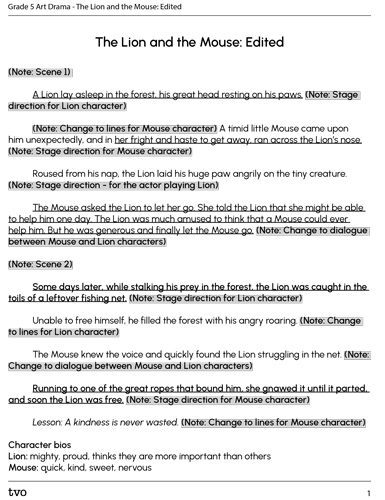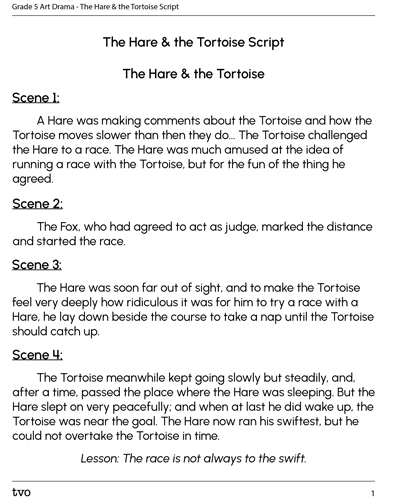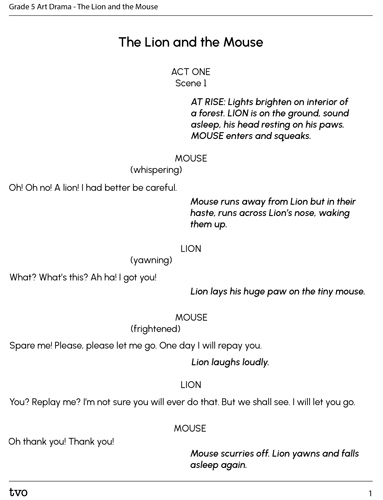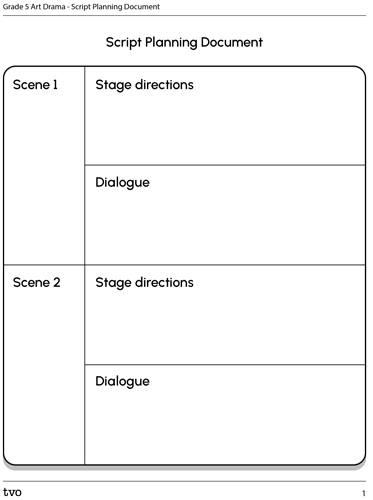Minds On
Warm up
Before you begin, don't forget to do your safety check!
Warm Up
Breathing exercise
Find a comfortable position. Focus your attention on one part of the body at a time.
How does that part of your body feel? If possible, take a deep breath and allow your lungs to expand.
Focus your attention on one part of your body. Allow that part to relax before moving on to the next. As you scan through your body, keep breathing deeply. Once you have completed the scan, take a moment to stretch.
If you wish, you can access this recording entitled “Deep Breathing” to complete your breathing activity.
Deep Breathing
Drama game
Let’s create something new out of everyday objects.
Select three objects, such as a chair, scarf or book, and imagine that they are something else entirely!

For example, a book might become a butterfly with its wings flapping.
Use your imagination!
Using your three objects, create a short drama story.
Let’s get started
Explore the following text. What do you notice? What do you wonder?

A page from a script for a play. The script indicates the setting, characters and dialogue. Act one. Scene one. At rise: Lights brighten on the interior of Dr. Jameson’s office. David sits reading the latest copy of Time magazine. He turns a page, sighs, turns another, sighs again and finally throws the magazine to the coffee table. He stands and begins pacing the room. Dr. Jameson enters and extends an open hand to David. Dr. Jameson (speaking): “David? I’m Dr. Jameson. Sorry about the wait. Fridays are always a crunch day for me. Tommy many people in too short of time”. David (speaking): “So business is really booming, huh?”. Dr. Jameson (speaking): “I guess you could look at it that way”. Dr. Jameson walks towards his office door and motions David inside. The script contains annotated notes along the margins of the page to explain the features of the script. “The Act and Scene citation usually is centered on the first page of dialogue; some writers put it all the way to the left of the margin. An alternative to this to note the act, scene and page number in the upper right-hand corner, numerically. Act One, Scene One, Page One would read 1-1-1, or Act Two, Scene One, Page 4 would read 11-1-4”. This note refers to the Act One, Scene 1 at the top of the page. “Number your pages” is a note at the top of the page next to the number 1. “Some writers capitalize the name of the character when he/she first appears”. This note refers to the first mention of Dr. Jameson in the script. “An alternative to this is to note TIME and PLACE”. This note refers to the term AT RISE at the beginning of the scene. “These are only the directions we need to know to start the scene i.e. what’s going on at the beginning of the play”. This note refers to the stage directions at the beginning of the scene. The character’s name is in all caps and centered. This note is referring to the character DR JAMESON. “Dialogue stretches from margin to margin. It is single spaced, or a space and a half, with a double space between two characters speaking”. This note is added in the margin next to a line of dialogue from Dr. Jameson. “These internal stage directions, or action, can appear here, or justified right and italicized”. This note is added in the margin next to the italicized direction “Dr. Jameson walks towards his office door and motions David inside.”
Do you recognize this form of writing?
Record your ideas using a method of your choice. Share your thoughts with a partner, if possible.
Action
Get ready, get set…
What is a playwright?

In the Minds On section, you explored an example of a script. Most playwrights use a script format to write their plays.
A playwright is someone who creates and writes a play. The play might follow a specific theme and express particular ideas. It might be trying to teach the audience about a topic or share a particular lesson. It might be funny or serious: it’s up to the playwright.
Dialogue
Dialogue is an important part of scripts. It moves the action along and gives the audience a sense of the characters in a drama production. An actor will consider the dialogue and decide how to deliver it using the help of a director. They will also consider which characters they are communicating with and work to establish relationships within a drama production.
Explore the following video for an example of dialogue between two actors.
Now, explore the following fable “The Lion and the Mouse” adapted from Aesop’s Fables.
"The Lion and the Mouse"

An angry lion holds a scared mouse by the tail.
A Lion lay asleep in the forest, his great head resting on his paws. A timid little Mouse came upon him unexpectedly, and in her fright and haste to get away, ran across the Lion’s nose. Roused from his nap, the Lion laid his huge paw angrily on the tiny creature.
“Spare me!” begged the poor Mouse. “Please let me go and some day I will surely repay you.”
The Lion was much amused to think that a Mouse could ever help him. But he was generous and finally let the Mouse go.
Some days later, while stalking his prey in the forest, the Lion was caught in the toils of a leftover fishing net. Unable to free himself, he filled the forest with his angry roaring. The Mouse knew the voice and quickly found the Lion struggling in the net. Running to one of the great ropes that bound him, she gnawed it until it parted, and soon the Lion was free.
“You laughed when I said I would repay you,” said the Mouse. “Now you see that even a Mouse can help a Lion.”
Pause and Reflect
Thinking like a playwright
Reflect on the following questions and record your thoughts using a method of your choice.
- How might we turn the story of the “The Lion and the Mouse” into a play?
- Which parts of the story would you turn into dialogue?
- What parts of the story would you turn into stage directions for the actors and the crew?
Consider exploring the following document “The Lion and the Mouse”: Edited, which is an example of how a playwright might have edited the story with post-it notes, underlined sections, and highlights to help them create a script. Also notice they considered the biographies for their characters.

Press the Activity button to access the “The Lion and the Mouse”: Edited.
Activity (Open PDF in a new tab)Finally, explore the following script for the fable “The Lion and the Mouse” from Aesop’s Fables. This would be the final version of the edited story.
Go!
Adapting fables
Imagine you are the playwright who is adapting the fable “The Hare & the Tortoise” for a drama production at a theatre company. The fable requires dialogue between actors for each scene.
Press the following tabs to begin exploring the character bios the actors will be performing.

Character bio: The Hare
- overconfident
- loves to talk
- athletic
Go through the story in role as the Hare. What would this character say? How would the character behave towards the Tortoise?

Character bio: The Tortoise
- strong
- determined
- patient
Go through the story in role as the Tortoise. What would this character say? How would the character behave towards the Hare?
Explore the story to help create your character bios.

“The Hare & the Tortoise”
A Hare was making comments about the Tortoise and how the Tortoise moves slower than then they do. The Tortoise challenged the Hare to a race. The Hare was much amused at the idea of running a race with the Tortoise, but for the fun of the thing he agreed.
The Fox, who had agreed to act as judge, marked the distance and started the race.
The Hare was soon far out of sight, and to make the Tortoise feel very deeply how ridiculous it was for him to try a race with a Hare, he lay down beside the course to take a nap until the Tortoise should catch up.
The Tortoise meanwhile kept going slowly but steadily, and, after a time, passed the place where the Hare was sleeping. But the Hare slept on very peacefully; and when at last he did wake up, the Tortoise was near the goal. The Hare now ran his swiftest, but he could not overtake the Tortoise in time.
Lesson: The race is not always to the swift.
Making notes
Use the following copy of the story to create notes. You may underline, highlight, and write notes in the margins of the page. If you would like, you can use speech-to-text or audio recording tools to record your thoughts. Consider adding your work to your drama portfolio.

Press the Activity button to access the The Hare & the Tortoise Script.
Activity (Open PDF in a new tab)Consolidation
Putting it all together
Using your planning notes from the Action section, create a first draft of your script of “The Hare & the Tortoise.”
Complete the Script Planning Document in your notebook or using the following fillable and printable document. If you would like, you can use speech-to-text or audio recording tools to record your thoughts. Consider adding your work to your drama portfolio.
Next steps
Explore the following video of professional playwright Suhayla El-Bushra and the advice they give about the writing process.
Revise your script and share it with a partner, if possible.
Reflection
Portfolio
Reflection
Reflect on the following questions and record your thoughts using a method of your choice. Consider adding your ideas to your drama portfolio.
- What did you learn about the relationship between the Tortoise and Hare through your script work? How did their relationship develop through the creation of dialogue in the script?
- Would you provide either character with a prop? Why or why not?
- Is there anything else you would like to change with your script revisions? What else might you do to gain more feedback to improve the dialogue?
Reflection
As you read through these descriptions, which sentence best describes how you are feeling about your understanding of this learning activity? Press the button that is beside this sentence.
I feel…
Now, record your ideas using a voice recorder, speech-to-text, or writing tool.

